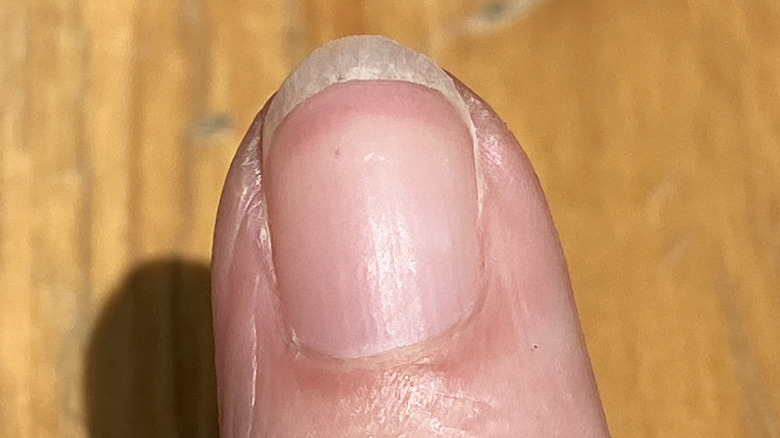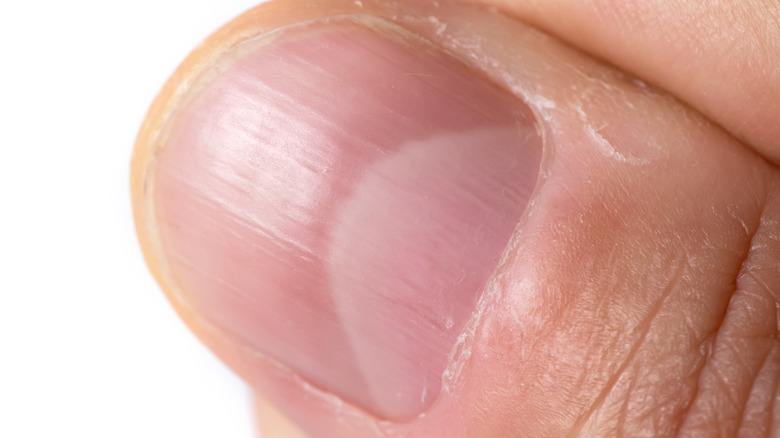What The Half-Moons Under Your Fingernails Can Tell You About Your Health
You might not think too much about your nails until you slam your fingers in a car door or notice some breakage from having acrylics applied regularly. But it's essential to pay attention to their overall health.
The nail is made up of several different parts. You see the cuticle and nail plate, but you also have a nail matrix under the plate and fold of the nail, according to the National Library of Medicine. The visible part of the nail matrix is called the lunula, or the little half-moon at the base of your nail. The lunulae are most prominently seen on the thumbs.
With that said, your lunulae may sometimes look a bit different — and when those changes come with other symptoms like brittle nails, they could mean that it's time for you to make an appointment with your doctor. Here are the various ways the half-moons on your fingernails may change, and the possible reasons why.
Color changes in the lunulae could be a sign of illness
It's important to pay attention to unexpected changes in any part of your body. For instance, you might notice when you have skin changes, especially on your face. It's also hard not to know when something is going on in your gut.
Similarly, the different colors of the lunulae — which are typically pale pink — can hint at a variety of possible conditions. For example, the American Academy of Dermatology Association (AAD) notes that a half-moon turning red could indicate lupus, heart disease, arthritis, or alopecia areata. Meanwhile, according to Healthline, a pale blue lunula could mean you have uncontrolled diabetes, a disorder where the pancreas doesn't produce insulin correctly, causing higher than regular blood sugar. Half-moons that are gray-blue can be a symptom of silver poisoning. Blue lunula can also mean that you might be dealing with Wilson's disease, where copper collects in your organs. Brownish lunulae, on the other hand, point to potentially serious issues with your kidneys.
The absence of half-moons may mean certain disorders
So you've noticed that your nails have been prone to breakage lately — and worse, your lunula seems to have disappeared. And while the absence of a lunula doesn't always mean something is seriously wrong with you, it is a possible sign of a major issue in your body (per Medical News Today).
For starters, malnourishment may cause your nail matrix to experience some changes, including the absence of a half-moon and a brownish look to your nails. This is especially the case with a vitamin B12 deficiency. Anemia can also cause the lunulae to disappear. This treatable condition, which causes the body to produce below-normal quantities of red blood cells, affects about three million people in the U.S. (via the National Heart, Lung, and Blood Institute). Its symptoms include dizziness, pale skin, and brittle nails.
Meanwhile, people with a missing half-moon and a strip of reddish brown near the tip of the nail might be experiencing Terry's nails, according to the Cleveland Clinic. This condition causes the whole nail to look washed out, typically due to heart failure, diabetes, cirrhosis, and liver issues.
A large half-moon could be linked to cardiovascular issues
When your lunula is larger than normal — about 50% of the nail — it could be a symptom of an endocrine disorder, infectious disease, cardiac issue, or congenital disorder (via ePainAssist).
Per a case study published in Cureus, enlarged lunulae can be associated with hyperthyroidism, leprosy, and scleroderma. Hyperthyroidism is a condition where the thyroid overproduces hormones, while scleroderma is an uncommon skin disease that leads to tightness and hardening of the skin, specifically the hands, feet, and face (via the Mayo Clinic). On the other hand, leprosy is a bacterial infection that causes discolored patches of skin and muscle weakness, according to the Centers for Disease Control and Prevention.
Additionally, the Cureus study notes that it could be trauma to the nail causing the deformity. Topical application of the steroid medicine hydrocortisone could also cause the half-moon on your nail to increase in size.




